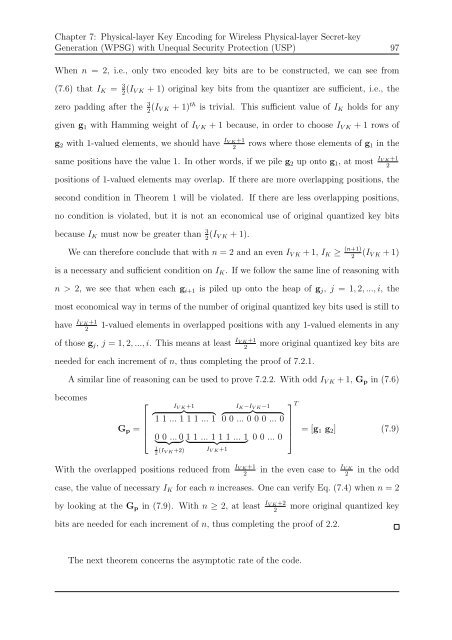Network Coding and Wireless Physical-layer ... - Jacobs University
Network Coding and Wireless Physical-layer ... - Jacobs University
Network Coding and Wireless Physical-layer ... - Jacobs University
Create successful ePaper yourself
Turn your PDF publications into a flip-book with our unique Google optimized e-Paper software.
Chapter 7: <strong>Physical</strong>-<strong>layer</strong> Key Encoding for <strong>Wireless</strong> <strong>Physical</strong>-<strong>layer</strong> Secret-key<br />
Generation (WPSG) with Unequal Security Protection (USP) 97<br />
When n = 2, i.e., only two encoded key bits are to be constructed, we can see from<br />
(7.6) that I K = 3 2 (I V K + 1) original key bits from the quantizer are sufficient, i.e., the<br />
zero padding after the 3 2 (I V K + 1) th is trivial. This sufficient value of I K holds for any<br />
given g 1 with Hamming weight of I V K + 1 because, in order to choose I V K + 1 rows of<br />
g 2 with 1-valued elements, we should have I V K+1<br />
2<br />
rows where those elements of g 1 in the<br />
same positions have the value 1. In other words, if we pile g 2 up onto g 1 , at most I V K+1<br />
2<br />
positions of 1-valued elements may overlap. If there are more overlapping positions, the<br />
second condition in Theorem 1 will be violated. If there are less overlapping positions,<br />
no condition is violated, but it is not an economical use of original quantized key bits<br />
because I K must now be greater than 3 2 (I V K + 1).<br />
We can therefore conclude that with n = 2 <strong>and</strong> an even I V K + 1, I K ≥ (n+1)<br />
2<br />
(I V K + 1)<br />
is a necessary <strong>and</strong> sufficient condition on I K . If we follow the same line of reasoning with<br />
n > 2, we see that when each g i+1 is piled up onto the heap of g j , j = 1, 2, ..., i, the<br />
most economical way in terms of the number of original quantized key bits used is still to<br />
have I V K+1<br />
2<br />
1-valued elements in overlapped positions with any 1-valued elements in any<br />
of those g j , j = 1, 2, ..., i. This means at least I V K+1<br />
2<br />
more original quantized key bits are<br />
needed for each increment of n, thus completing the proof of 7.2.1.<br />
A similar line of reasoning can be used to prove 7.2.2. With odd I V K + 1, G p in (7.6)<br />
becomes<br />
⎡<br />
G p = ⎢<br />
⎣<br />
I V K +1<br />
{ }} {<br />
1 1 ... 1 1 1 ... 1<br />
0} 0 {{... 0}<br />
1} 1 ... 1{{ 1 1 ... 1}<br />
1<br />
2 (I V K+2) I V K +1<br />
I K −I V K −1<br />
{ }} {<br />
0 0 ... 0 0 0 ... 0<br />
0 0 ... 0<br />
⎤<br />
⎥<br />
⎦<br />
T<br />
= [g 1 g 2 ] (7.9)<br />
With the overlapped positions reduced from I V K+1<br />
2<br />
in the even case to I V K<br />
2<br />
in the odd<br />
case, the value of necessary I K for each n increases. One can verify Eq. (7.4) when n = 2<br />
by looking at the G p in (7.9). With n ≥ 2, at least I V K+2<br />
2<br />
more original quantized key<br />
bits are needed for each increment of n, thus completing the proof of 2.2.<br />
The next theorem concerns the asymptotic rate of the code.

















